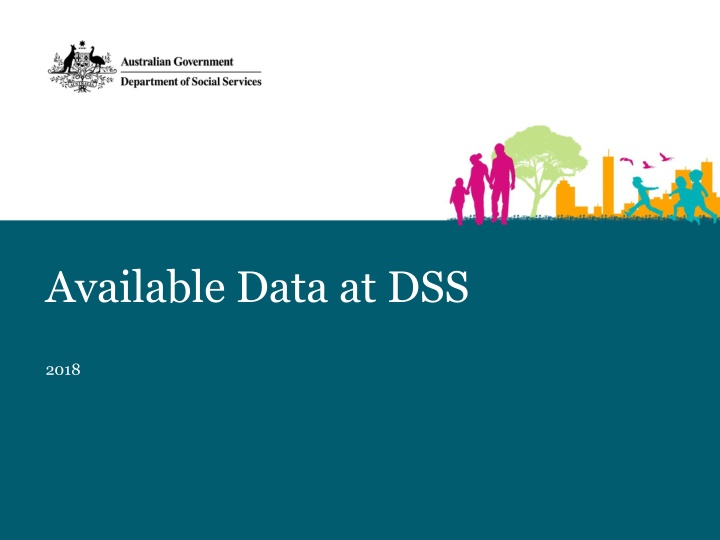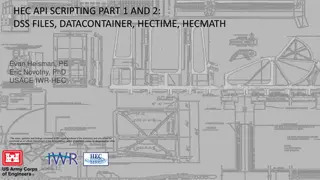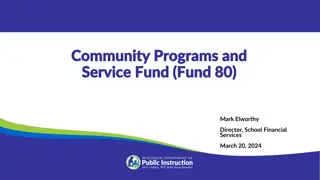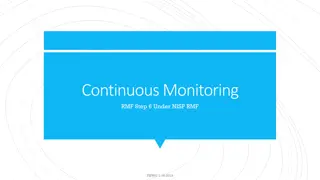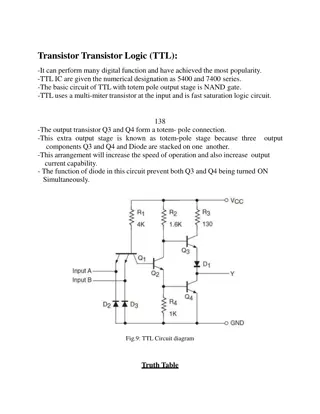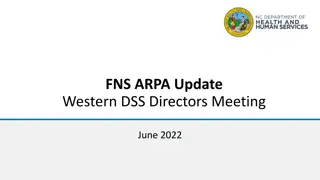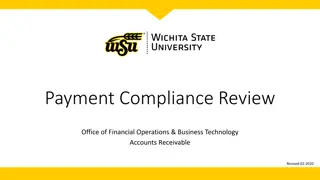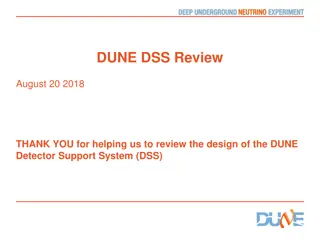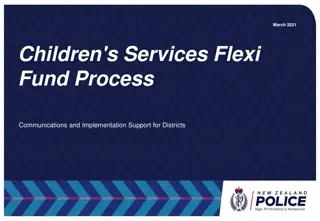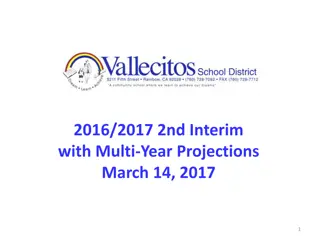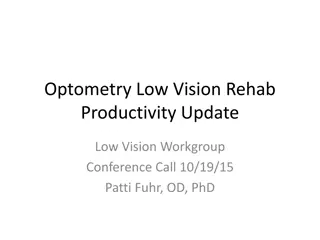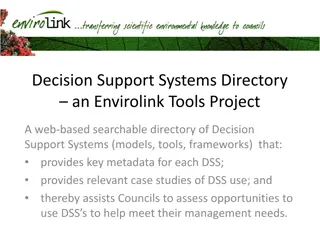Available Data at DSS 2018 - Evidence for TTL Fund Application
This collection showcases various types of data available at the Department of Social Services (DSS) in 2018, including statistical reports, longitudinal survey data, Priority Investment Approach (PIA) data, and more. Utilizing this data can help support applications for the Try, Test, and Learn (TTL) Fund by providing evidence of the long-term welfare risk among targeted individuals and demonstrating the necessity of projects that aim to address this issue. The extensive longitudinal surveys, such as HILDA, LSAC, LSIC, and BNLA, offer valuable insights into different aspects of Australian society, making them valuable resources for research and policy development.
Download Presentation

Please find below an Image/Link to download the presentation.
The content on the website is provided AS IS for your information and personal use only. It may not be sold, licensed, or shared on other websites without obtaining consent from the author.If you encounter any issues during the download, it is possible that the publisher has removed the file from their server.
You are allowed to download the files provided on this website for personal or commercial use, subject to the condition that they are used lawfully. All files are the property of their respective owners.
The content on the website is provided AS IS for your information and personal use only. It may not be sold, licensed, or shared on other websites without obtaining consent from the author.
E N D
Presentation Transcript
How might this be relevant to your grant application for the TTL Fund? The assessment criteria outlined in the Try Test and Learn Fund grant opportunity guidelines encourages you to provide evidence provide evidence that the people targeted by your project are at risk of long-term welfare dependence (e.g. evidence may include Priority Investment Approach data, research, government reports, empirical evidence, etc.); provide evidence of the need for your project among those it would support (e.g. evidence may include Priority Investment Approach data, research, government reports, empirical evidence, etc.) Available Data at DSS 2
Types of Data Available Statistical Reports Longitudinal Survey Data Priority Investment Approach (PIA) Data DOMINO Data Requests Available Data at DSS 3
Statistical Reports Available Data at DSS 4
Statistical Reports Available Data at DSS 5
Statistical Reports Available Data at DSS 6
Longitudinal Surveys National Centre for Longitudinal Data www.dss.gov.au/ncld Available Data at DSS 7
Longitudinal Surveys: National Centre for Longitudinal Data The Household, Income and Labor Dynamics in Australia Survey (HILDA) The Longitudinal Study of Australian Children (LSAC) The Longitudinal Study of Indigenous Children (LSIC) Building a New Life in Australia (BNLA) Available Data at DSS 8
Four Longitudinal Studies HILDA Wave 13 LSAC Wave 5 LSIC Wave 6 BNLA Wave 1 www.dss.gov.au/ncld Available Data at DSS 9
The Household, Income and Labour Dynamics in Australia (HILDA) Survey WHO? More than 9,000 households More than 17,000 individuals WHERE? Representative of urban and regional areas across Australia HOW OFTEN AND FOR HOW LONG? Surveys are run every year and started in 2001 Available Data at DSS 10
The Household, Income and Labour Dynamics in Australia (HILDA) Survey WHAT IS IN IT? Household, budget and income information as well as family information such as caring, health and disability, and personal information such as education, wellbeing and relationships. WHERE CAN I GET IT? www.dss.gov.au/ncld Available Data at DSS 11
Growing Up in Australia: The Longitudinal Study of Australian Children (LSAC) WHO? 10,000 children originally recruited WHERE? Representative across Australia by population density HOW OFTEN AND FOR HOW LONG? Surveys are run every second year and started in 2004 Available Data at DSS 12
Growing Up in Australia: The Longitudinal Study of Australian Children (LSAC) WHAT IS IN IT? Family relationships, home environment, health and wellbeing, education, work and care responsibilities, risk behaviour and intergenerational information Some linked data WHERE CAN I GET IT? www.dss.gov.au/ncld Available Data at DSS 13
Footprints In Time: The Longitudinal Study of Indigenous Children (LSIC) WHO? 1,700 indigenous children WHERE? Surveys conducted in remote, rural and urban locations across Australia HOW OFTEN AND FOR HOW LONG? Surveys are conducted every year and started in 2008 Available Data at DSS 14
Footprints In Time: The Longitudinal Study of Indigenous Children (LSIC) WHAT IS IN IT? Family relationships, housing, education, cognitive development, health, employment, connection with indigenous culture, and experience of racism WHERE CAN I GET IT? www.dss.gov.au/ncld Available Data at DSS 15
Building a New Life in Australia: The Longitudinal Study of Humanitarian Migrants (BNLA) WHO? 1,500 migrating units WHERE? Large and small communities around Australia HOW LONG? Surveys are conducted every year and started in 2013 Available Data at DSS 16
Building a New Life in Australia: The Longitudinal Study of Humanitarian Migrants (BNLA) WHAT IS IN IT? Housing and resources, language, education, employment, health, access to services, community support and their life experiences before coming to Australia WHERE CAN I GET IT? www.dss.gov.au/ncld Available Data at DSS 17
Priority Investment Approach (PIA) Data Available Data at DSS 18
The three access points to PIA data provide tiered access to enable greater accessibility to a wider audience while maintaining privacy PIA in SURE TableBuilder Synthetic Data Applications are considered and approval based on user expertise and need for the data in context of a specific project Unrestricted access Unrestricted access Accessibility User pays an access fee Free registration Free registration User Access Once users log in, they are able to construct tables of aggregate data freely, without constraint. These tables can then be downloaded as .csv files without review. Users do not see the unit level record data at any stage Once approved, access is within a secure enclave and users will see unit record data. All analyses are run remotely within the secure enclave. Output must be approved before being taken out of SURE Users can download the complete dataset of unit level record data to use on their own system User Experience AIHW secure environment AIHW secure environment ABS Tablebuilder site ABS Tablebuilder site Dataverse Dataverse Sources 60 38 31 Number of Variables Rounded to the month Rounded to the year Rounded to the decade Format of Date of Birth Country by Region (Birth and Residence), State, Postcode, Address at SA3 level Country (Birth, Residence and Citizenship), State, Postcode Country (Birth and Residence), Postcode Geographic Information Access to Priority Investment Approach (PIA) Data 19
Priority Investment Approach (PIA) Data The PIA Research dataset is a subset that includes 14 years of information about payment recipients over 56 quarterly snapshots from July 2001 to June 2015. The data contains information about those people who have received one of 21 benefits including Aged Pension, Disability Support Pension, Newstart Allowance, Youth Allowance and Carer Payment. The de-identified information includes demographic and geographical information, as well as information relating to accommodation, primary medical conditions, education and income. Demographic variables of the partner are also available for some of the recipients. Available Data at DSS 20
PIA Data in SURE (and the Synthetic Data) AUDIENCE Researchers with advanced analytics skills FUNCTION Unit-record level data for research purposes LOCATION www.aihw.gov.au/our-services/data-on-request/dss-data Available Data at DSS 21
PIA Data in TableBuilder AUDIENCE Everybody Teachers and students Academics Non Government Organisations FUNCTION Create and download both tables and graphs Population estimates LOCATION Australian Bureau of Statistics Available Data at DSS 22
DOMINO Data Over Multiple Individual Occurences Available Data at DSS 23
Data Over Multiple INdividual Occurrences (DOMINO) Program grants and funding Settlement Services Pensions Concession Cards Working age payments Available Data at DSS 24
Data Over Multiple INdividual Occurrences (DOMINO) Integrated Research Data Mart of DSS Administrative Analytical Data Assets. Event-based structure that tracks changes in individuals circumstances over time and interactions with both Social Security Payments and DSS managed programs. Enables tracking of individual customers as they interact with DSS longitudinally throughout their life course. Available Data at DSS 25
Data Over Multiple INdividual Occurrences (DOMINO) Available Data at DSS 26
DOMINO Data in SURE AUDIENCE Researchers with advanced analytics skills FUNCTION Unit-record level data for research purposes Designed for linkage studies LOCATION www.aihw.gov.au/our-services/data-on-request/dss-data Available Data at DSS 27
Data Requests Insert presentation title in footer 28
DSS Data Requests AUDIENCE Those whose question can not be answered through other available data sources FUNCTION Provide group level (aggregate) data or reports LOCATION data.requests@dss.gov.au Available Data at DSS 29
Types of Data Available Statistical Reports Longitudinal Survey Data Priority Investment Approach (PIA) Data DOMINO Data Requests Available Data at DSS 30
Any Questions? Thank you. Tara Spokes, PhD Policy Research Officer tara.spokes@dss.gov.au Access to Priority Investment Approach (PIA) Data 31
